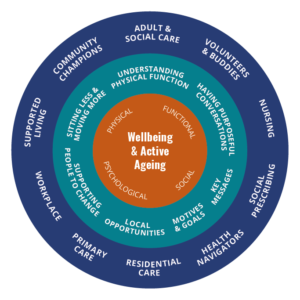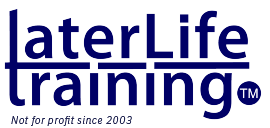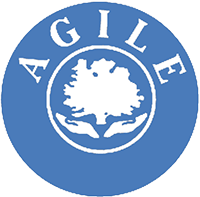Our Foundations for Wellbeing and Active Ageing learning modules allow you to design bespoke training for your workforce. They expand our remit to work further upstream to identifying whole workforce education and training opportunities aligned to the promotion of physical activity and the promotion of Wellbeing and Active Ageing.
Wellbeing and Active Ageing provide inclusive and “umbrella concepts” and a common focus for multiple professional and public audiences. They provide a positive message derived from our ability to understand and act upon our own capacity to lead a purpose-filled and engaged life.
Regardless of which definition or model is adopted e.g., the World Health Organisation, the Social Care Institute for Excellence, the International Council on Active Aging or The New Economics Foundation, opportunities for purposeful and meaningful physical activity are at the heart of Wellbeing programmes.
Wellbeing and Active Ageing also offer an important alternative physical activity message and compliments current disease prevention, frailty and decline messages so prevalent in relation to physical activity and ageing.
Using our Wellbeing Wheel, our short Foundations for Wellbeing and Active Ageing education courses can be tailored to different populations and settings to accommodate the needs of those people you work with.
Your workforce
The outer circle provides examples of the different types of workforce with the potential to promote wellbeing. As new services and programmes are configured, others workforce descriptors will emerge.
 Build your wellbeing education
Build your wellbeing education
You can select from a menu of key educational elements found in the middle circle that can lead to an informed, motivated and skilled workforce.
- Sitting less and moving more – Understanding the importance of moving to the individual (benefits and risks) and “Best fit/link” of movement approaches to service priorities
- Having good conversations – Opportunities for purposeful and meaningful conversations including appropriate messaging, leading to goal led actions over time based on the Make Every Contact Count and COM – B processes.
- Understanding physical function – the key components of movement and functional fitness related to activities of daily living, mobility and independence (underpinned by UK CMO Guidelines) e.g., strength, balance, coordination, flexibility and mobility
- Supporting people to change – Informed by behavioural change principles, examining individual, social and environmental barriers and facilitators and support to change over time
- Key messages – How the key elements of functional fitness and moving can be translated into educational and motivational messages for different people
- Motives and goals – Helping people recognise their own motivation and set their own realistic and achievable goals and targets and to achieve regular movement habits
- Opportunities to be active – To recognise the availability, accessibility and appropriateness of age friendly local opportunities to facilitate personal choice
This content would also contribute towards the wellbeing of your own workforce as well as those they support.
Over the last 10 years, progress has been made with services and programmes delivered by qualified physical activity and exercise trained professionals to the already motivated and confident older population. However, there are multiple workforces without such specific training or a background in understanding movement, physical activity and ageing, but who are in a unique and advantageous position to engage with and support inactive older people.
New – the context and consequences of COVID 19
For these people, the period of lockdown, isolation and avoidance of large social gatherings and opportunities brought about by the Covid 19 pandemic will have increased levels of inactivity (particularly amongst those aged 70+ who “self-shielded”, those with long term conditions and those who had Covid 19). Evidence is now emerging of subsequent significantly lower levels of functional (physical and psychological) capacity, increases in loneliness and levels of anxiety and feelings of being disconnected. People will require support to reconnect with family, friends and their communities. NB., this period of inactivity will also have increased the risk of accidental falls and fractures and other associated health risks.
New – “inactives”, those we have yet to reach
Over 70% of people over the age of 65 are classed as inactive. These people are often described as having insufficient physical function, self-efficacy, skills and support to take advantage of existing opportunities to be active e.g., walking, exercise at home (via online/paper educational materials) or participate in local community settings or groups. Their level of inactivity and sedentary behaviour continues to affect their health and physical, social or psychological function. However, for whatever reasons, so far we have failed to reach these people with messages, opportunities and support that inspire or are meaningful to them and engaging with them remains the greatest challenge.
New – messages about movement
There is evidence that both professionals and the public are currently confused by multiple messages related to the promotion of physical activity. Movement is a concept more easily understood by older populations and can be interpreted in a variety of ways. There are few, if any, educational and training programmes designed to address populations for whom these and similar messages are a priority. For these older people, appropriate messages may include “sit less move more” (break up your sedentary behaviour) and “do something every day” (develop a movement habit and routine), both key recommendations from the recent 2019 UK CMO Guidelines for Older Adults 65+.
NB. For more information on the 2019 UK CMO Guidelines for older adults 65+, click to view the CMO Guidelines and the Physical activities for older adults infographic.
Later Life Training (LLT) is a unique training provider, known across the UK and Europe for a commitment to evidence-based practice and qualifications for those working with older people at risk of falls and stroke survivors. Find out more about our history.
This Foundations to Wellbeing and Active Ageing programme expands and enhances our remit to work further upstream to identify whole workforce education and training opportunities aligned to the promotion Wellbeing and Active Ageing.
We will listen and talk with you about the needs of the people you work with and depending on your setting or workforce (and associated scope of practice and requirements for training frameworks) we can work with you to design bespoke education modules.
We will enable you to select relevant learning and development requirements appropriate to your own workforce from our Wellbeing Wheel. These can be delivered through a bespoke programme of content, as a whole or a modular approach and available through the choice of online and (as and when appropriate) face-to-face or blended learning sessions. Tell us what you want your workforce to achieve and we can help you to:
- Undertake an audit of your current wellbeing activity to achieve a clear picture of current position
- Clarify the purpose of your workforce development and stages of implementation
- Highlight the knowledge, skills and understanding required for your successful workforce
- Recognise and work with the (individual and organisational) barriers and facilitators to implementation
- Engage with stakeholders and partner organisations to increase understanding
- Monitor progress and evaluate your successes
Scale and scope
No project is too big or too small for us. For example, we can deliver
- awareness raising webinars for potential stakeholders and partner organisations
- single 2 hour modules for above 8 learners
- a series or programme of linked modules delivered to a whole local workforce over time
- seperate but related modules for different groups within a whole workforce e.g. service managers, front line staff
Download our planning tool which will assist your thinking and for a discussion about your thoughts on workforce development in Wellbeing and Active Ageing. Also available to download below is our Foundations to Wellbeing and Active Ageing flyer to share information about these educational opportunities with your colleagues, stakeholders and partners.
Examples of education and training development already delivered by Later Life Training using different key elements of the Wellbeing Wheel include:
Sheltered supported living – Anchor/Hanover Housing
Purpose – to increase independence and functional fitness amongst residents. Key elements of workforce learning and development included:
- Strategic fit of programme to existing wellbeing services
- The importance of functional fitness and ageing
- Undertaking individual functional fitness assessments
- Engaging residents in purposeful conversations
- Mapping, analysing and promoting appropriate local opportunities and programmes
- Strategies to support residents to take up new opportunities
- Evaluation of programme impact upon functional fitness
Read the report from Anchor Hanover here…
Local physical activity network – The Active Devon partnership
Purpose – to build workforce capability amongst physical activity professionals and increase confidence and awareness of their role in supporting older people
- Audit of local workforce skills, qualifications and current activity within local partnership
- Establishing accurate ‘view’ of what is in place and clarity about who it is most appropriate for
- Clarity about appropriate programming and scope of practice
- Key understanding from 2019 UK CMO Guidelines on functional fitness and ageing and appropriate messaging
- Facilitating change in physical activity participation over time
- Outlining appropriate support strategies
Support for professional and family dementia care givers – Bridgend County Borough Council
Purpose – to provide education to the (formal and informal) caregiver workforce framework for the promotion of everyday movement opportunities for people living with dementia
- Audit and background research to barriers and facilitators to physical activity and dementia for care givers
- Engagement seminar with service managers and leads
- Drafting of outline for service intervention and identifying key messages and strategies for implementation
- Educational seminars for provider managers and coordinators in advance of seminars for front line staff
- Detailed support for interventions for purposeful conversations between care givers and people living with dementia
- Integration of key interventions into local care inspection services
Local fitness and physical activity service providers – A Strong and Balanced Offer – Inspiring Healthy Lifestyles Wigan
Purpose – to highlight the importance of strength and balance messages and enhance provision for older people within local service providers
- Initiate and support a co-production strategy with representative local groups of older people and local stakeholders
- Devise educational programme for older people groups on functional fitness in later life and key messages
- Support older people groups undertaking an audit of local strength and balance opportunities and programmes
- Seminar with gym and health club workforce on strength and balance assessment, motivation and support for ageing populations
- Older people groups dissemination of findings to stakeholders and service managers
Read the Strong and Balance Offer report here
Read the paper “Co-Creating Recommendations to Redesign and Promote Strength and Balance Service Provision” here
Volunteer workforce – reaching inactive and isolated people at home – Bristol ACE (Active Connected Engaged) programme
Purpose – to build volunteer workforce to reach older people at home with the skills to engage, motivate and support them to make the most of local opportunities to get out and about
- Audit of effective volunteering and peer mentoring strategies
- Programme planning with stakeholders to identify target locations, populations and evaluation outcomes
- Development of volunteer workforce recruitment and support strategies
- Drafting of education and training for volunteer workforce (including underpinning behaviour change strategies)
- Delivery of modular education and training for volunteer workforce
A whole organisational approach to dementia provision – Crawley Town FC
Purpose – to build capacity amongst the club Community Foundation section to deliver appropriate programmes and activities:
- Awareness raising on people living with dementia and their informal care-givers
- Audit of current “dementia friendly” facilities, places and spaces including the football club
- Knowledge and understanding of the benefits of physical activity and sport for people living with dementia
- Person centred approaches and communication with people living with dementia involved with the club
- Mapping of potential local services and activity provider organisations
Volunteer Workforce – Walk With Me (Belfast, Northern Ireland)
Purpose – to test the feasibility of a peer-led, multicomponent physical activity intervention in socio-economically disadvantaged community dwelling older adults in Belfast by testing:
- The recruitment, training and management of a group of peer mentors, working in collaboration with community partners
- The feasibility of a peer-led walking programme targeting inactive older adults in a randomised controlled pilot study, to inform the design of a main trial should the trial prove feasible
- Social Cognitive Theory was used in the design of the Walk with Me intervention involving the recruitment and training of Walk With Me Peer Volunteers
- The peer mentors’ roles were planned to effectively influence personal, environmental and behavioural factors and their role in physical activity behaviour change.
- The 12-week intervention began with an activation stage (weeks 1 – 4) face-to-face meeting between the peer mentor and the participant to establish a rapport and build a trusting relationship
- The programme continued (behavioural practice stage, weeks 5–8) with the participant and mentor meeting at least once every 2 weeks to walk and discuss goals/barriers to increasing physical activity.
- The final 4 weeks (habit formation stage, weeks 9–12) emphasised behaviour rehearsal and practise by walking regularly in a locally accessible physical activity environment (e.g. local park).
- The final weeks of the structured component of the intervention provided an opportunity for the participant and mentor to discuss other community-based physical activity opportunities and to attend a local community group (e.g. Mens’ Shed) to facilitate the maintenance of physical activity behaviours at the conclusion of the intervention.


